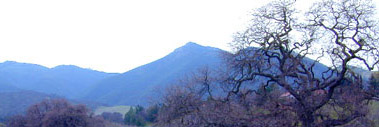 |
No doubt readers are now asking, so what is life like in a place with a name like that? Well might they ask, as the Victorian novelist used to say. To explain: 
Pictured above is a skyline that we see from the freeway on most trips away from the house–the tallest peak is Mt. Diablo, whose once-in-a-blue-moon's snowy summit may have given the Spaniards some problems, but Mt. Diablo does not seem to host any devils. The barely discernible town seen at the foot would be Walnut Creek, one of the usual small towns that cluster at it's feet, like Martinez [where we usually are, as we work here]. At the time of the big quake, we were in "Pleasant Hill" which is crossed into without any fuss at all from Martinez [which Rachman used to give a bit of style to by pronouncing MART-ta-nez, but I fear it's really Mar-TEEN-ez, a very common Spanish surname]. Martinez's only claim to fame is that it was the home of conservationist, John Muir, a Scotsman, who immigrated over here around the turn of the century.
Some of you have wondered how Americans get on without fairies, ley lines, etc. The truth is many of us do not have to, as you may have guessed, and "places" are where you find them.
Whatever these marvelous creatures called fairies, pixies, etc., are–they seem to have immigrated along with us. I could cite some experiences, and you might note the title of Olivia's book, and other signs that a secret immigration has been taking place. I'm not suggesting that such things can be written off as ancestral, cultural inheritance, although this is a partial explanation (different cultures come up with different names for these things, but there is a universal quality to them). Mas Prio Hartono speaks of krises and wayang figures, a whole cosmos that has the feeling of being somehow universal, although transmitted in Javanese terms.
It takes a time for the Western mind to reflect, but visions of Excaliburs, Grails, and myriad talismans and amulets finally occur, our own lost ancestral equivalents, once denied, but now seeking their way into our present day world.
Domain of the Elf King 
Awhile back, I clipped an article describing the death of a man and woman, who had answered the call of "flying saucer folk." Apparently they drove their car to an isolated location and waited for days to be "picked up," finally freezing to death in the Minnesota winter. In this high tech age, a couple were enchanted and carried off to the elf king's domain from which not all return. What elf king, and where his story originated, may not be the point at all. It was a marvelous, if tragic example of some of the "blessed saucerians." I coined the phrase "blessed saucerian" because the study of saucerians helped me to comprehend the fact that intense belief can create genuine solid-object style effects. It came from the words of a person cured at Lourdes, who when asked about the miracle, replied, "Actually, I think it was the blessed sick themselves..." I stress some saucerians, this is not intended as the explanation of the mystery of the saucers, it is only a possible facet.
This "answer," however, put me on the trail of an intriguing question, how many strange "events" are now taking place in the modern world created solely by the intense belief of diverse groups of people?
New Age Impact Looking at the increase in phenomena like the saucers,
Wonders abound, but coincide with signs that a new dark age may also be threatening. Perhaps a more pertinent question, if that is the trend, is why a highly civilized modern world [wherein many age old problems have been solved] seems to be moving to a new dark age? There may truly be no answer for that–for example, a distinguished anthropologist comments that he will not join the undignified rush to study the emerging inner-city primitives because the study of existing stone age cultures has produced no solid comprehension of man's real nature. But the rush has already started. And if the downward trend continues, a more practical question is how is one to survive, if one chooses not to join the self-destructive or is unequal to becoming a member of the "ravening horde." If you'd rather not be disturbed, we ask your pardon. Let us introduce a more pleasant image and symbol, the survival instinct. History (which is the only guide man may have about his own behavior as a herd animal, if only he could understand it) has one dark age on its open pages–it's the one with all the castles and knights running about on goodly errands. Most of us also know that there were decidedly grimmer and more gruesome sides to this dark age, such as the black plague, for example. But it is the only model we have. A happy note is that however bad the dark age became, man did not keep sinking to levels below that "lost golden age" he so sadly lamented in the middle ages. So finally, there came the Renaissance (with its nasty problems), and if some of the ages that followed did not exactly shine (when taken a hard look at), they were not the stone age.
This may have been because a segment of the dark age population took on the task of preserving the wisdom of the lost "golden age."
|
| |

Copyright© 2007, Undiscovered Worlds Press
|
|
 If you've taken in the local place names, you've got the picture. But with Lindsay going on about the foot of Ben Lawers, I felt I would at least trot out our local place name. We know that some of you think of us as living in a rather colorful area–and over many a hill and dale [both here and in the city] that is probably true. But truthfully, we don't see a lot of it.
If you've taken in the local place names, you've got the picture. But with Lindsay going on about the foot of Ben Lawers, I felt I would at least trot out our local place name. We know that some of you think of us as living in a rather colorful area–and over many a hill and dale [both here and in the city] that is probably true. But truthfully, we don't see a lot of it.
 I believe that I can name a few of these as absolute certainties, but this "answer" is also not the point, it's rather a door to unsolved mystery. Modern physics has already extended to the knowledge that objective reality is a bit more mythological than would be supposed, because the experimenter affects the experiment. There is objective reality, at least in the form of the general consensus and even if we are able to perceive it only partially. The general consensus [what most people believe with variations] is a reality. Nature, the laws of physics, etc. as part of the general consensus cannot be easily defied even if the general consensus is held in place only because enough of the world population believe it. What is happening, of course, is probably not due to conscious thoughts so much as alterations in that realm of universal mind which is not conscious.
I believe that I can name a few of these as absolute certainties, but this "answer" is also not the point, it's rather a door to unsolved mystery. Modern physics has already extended to the knowledge that objective reality is a bit more mythological than would be supposed, because the experimenter affects the experiment. There is objective reality, at least in the form of the general consensus and even if we are able to perceive it only partially. The general consensus [what most people believe with variations] is a reality. Nature, the laws of physics, etc. as part of the general consensus cannot be easily defied even if the general consensus is held in place only because enough of the world population believe it. What is happening, of course, is probably not due to conscious thoughts so much as alterations in that realm of universal mind which is not conscious.  visitations and visions of many kinds, perhaps even a geophysical world which is moving to a more active phase, one cannot escape the feeling that the general consensus under the impact of this New Age is rather like an old creaking house lashed furiously by wind and rain. The rain comes in through the roof, the broken windows, wind slips under sagging doors, and one becomes aware that the house is resting on a trembling foundation. Attempts to shore it up may be made by those desperate to hang onto the world view of a bygone age, but the conviction grows that such gestures, even if one sympathizes, are useless.
visitations and visions of many kinds, perhaps even a geophysical world which is moving to a more active phase, one cannot escape the feeling that the general consensus under the impact of this New Age is rather like an old creaking house lashed furiously by wind and rain. The rain comes in through the roof, the broken windows, wind slips under sagging doors, and one becomes aware that the house is resting on a trembling foundation. Attempts to shore it up may be made by those desperate to hang onto the world view of a bygone age, but the conviction grows that such gestures, even if one sympathizes, are useless.
